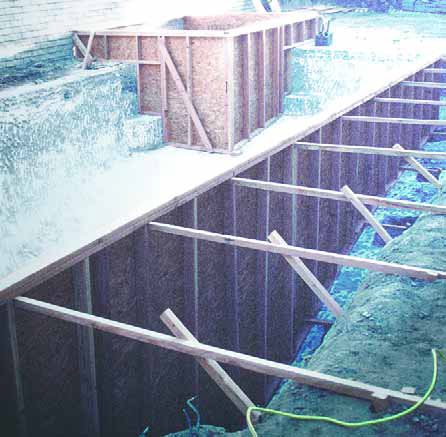architecture
One of the things I like most about working with water is that it makes statements that don't require much verbal explanation. In fact, I like to think that the projects I build speak volumes about my clients' desire for something creative and interesting. They also speak to the point that most of my clients grant me the freedom to give my very best effort, both aesthetically and technically, without many constraints. Not all the work I do is so modern in style or approach as the project pictured in these pages, but this one illustrates a principle that's become a
Last time, I mentioned initial meetings and discussions having to do with a retrofit project in Pacific Palisades, Calif. I call it a "retrofit" because we're using a portion of an existing pool shell as part of the new one, but in truth this is really a ground-up reworking of the entire environment. This project displays the influence that architects Ricardo Legoretta and Luis Barragan have had on my thinking about shapes, colors and spatial relationships. As soon as I saw this place, in fact, the work of both came to mind because of the strong colors and materials and the expressive
A grand California estate deserves a grand pool, and Cima del Mundo is certainly no exception. The new pool is part of a project that involves the complete renovation of a classic estate in the hills of Montecito, a prosperous enclave just south of Santa Barbara, Calif. In keeping with the overall theme of the project, which was described in detail in "The Crest of the World" (WaterShapes, January/February 2001, page 32), the pool has been outfitted with thoroughly
It's a grand watershape built at a time and place when "grand" was in fashion in so many ways. Ever since 1940, when the Raleigh Hotel and its beautiful swimming pool opened to the public for the first time, the establishment has made a statement about the sun-drenched glory of a prime South Florida location as well as the glamour of an era gone by. Designed and built by renowned architect L. Murray Dixon, the hotel and pool are located in South Beach, Miami's famed Art Deco district. The pool's curvaceous shape and modern styling reflected the hotel's architecture and the aspirations of the times. As the '40s wore on, it would become a swimming pool that was perfectly in sync with the world around it. When Miami boomed in the years following World War II, the hotel did, too. Vacationers and snowbirds from the great cities of the Northeast arrived in droves, looking for a new kind of excitement and an entirely different sort of glamour of the kind that featured
To be honest, I've never been a huge fan of New Year's resolutions. And I especially don't cotton to all the sentimental windbagging that seems to attend the "dawning" of this new era or that. But on this occasion, and for reasons all too many and obvious, I won't shy away from
It's one of the most famous buildings in the world, but few people know that Frank Lloyd Wright designed Fallingwater in a matter of hours. In 1935, when Wright first received the commission to design and build a vacation home for Pittsburgh retail tycoon Edgar J. Kaufman and his family in Mill Run, Pa., he didn't get to the project right away. After several months of preliminary discussions and delays, Kaufman decided to force the issue, telephoning the architect and saying that he was going to visit Wright's studio to see what had been done. It was at that point Wright decided he'd better design the house. He had a weekend. The construction process was no more direct, but it took longer. Work began in 1936 and was completed by 1939 in a series of costly fits and starts. The project was originally set to cost in the neighborhood of $40,000, but the final tally rose to nearly ten times that amount - not inconsiderable in post-Depression America. The result of the dramatic (and, at times, traumatic) process of design and construction is nothing less than one of the greatest achievements in American architecture, a work so compelling that it never stops
It's one of the most famous buildings in the world, but few people know that Frank Lloyd Wright designed Fallingwater in a matter of hours. In 1935, when Wright first received the commission to design and build a vacation home for Pittsburgh retail tycoon Edgar J. Kaufman and his family in Mill Run, Pa., he didn't get to the project right away. After several months of preliminary discussions and delays, Kaufman decided to force the issue, telephoning the architect and saying that he was going to visit Wright's studio to see what had been done. It was at that point Wright decided he'd better design the house. He had a weekend. The construction process was no more direct, but it took longer. Work began in 1936 and was completed by 1939 in a series of costly fits and starts. The project was originally set to cost in the neighborhood of $40,000, but the final tally rose to nearly ten times that amount - not inconsiderable in post-Depression America. The result of the dramatic (and, at times, traumatic) process of design and construction is nothing less than one of the greatest achievements in American architecture, a work so compelling that it never stops
In October 1999, I wrote an Aqua Culture column titled "Value by Design" in which I explained my belief that watershape designers should be paid for their designs in the same way interior designers and landscape designers are paid for theirs. Since then, I've been contacted by lots of people who are interested in knowing more about how this works; I've also had the privilege of traveling throughout the United States and abroad to talk about watershape design and construction and have met hundreds of people with the same need for information. On the one hand, it's exciting to see the notion of a watershape-design specialty catching on: It isn't a foreign idea to people the way it used to be, and
Good design isn't the sole province of any one country: It's something that happens around the world in response to local flavors and textures and the needs and desires of people who live there. Most of these watershape markets are absolutely minuscule by comparison to the U.S. market - but in each location you'll find clients who are just as interested as their American counterparts in commissioning watershapes that reflect high aspirations, suitable affluence and
Helena Arahuete joined the staff of John Lautner's architectural firm in the early 1960s, at a point where he was turning out some of his most spectacular work. Indeed, Lautner can indisputably be said to have designed some of the most beautiful and unusual homes built in the second half of the 20th Century. An apprentice of Frank Lloyd Wright's who studied with the master at Taliesen, Lautner was an exponent of the philosophy and discipline known as "Organic Architecture," an approach Arahuete, now an eminent architect in her own right, has continued to use and refine while running the firm that still bears Lautner's name. She is now one of the world's leading practitioners of Wright's and Lautner's approach to creating unique structures that are intricately and intimately tied to their surroundings. She is also so firm a proponent of the integration of watershapes into those architectural forms that in April 2000, she carried her message to the first Genesis 3 Level II Design School, held in Islamorada, Fla. - and welcomed an opportunity to present some of Lautner's work here by way of defining the place watershapers have at the design table with





















